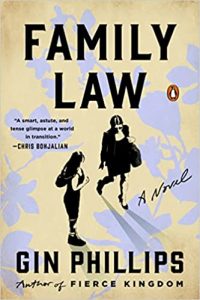A Persistent What-If: The Complicated and Inelegant Process of A Book Idea
A Persistent What-If: The Complicated and Inelegant Process of A Book Idea
Gin Phillips
 Stop me if you’ve heard this one: A writer walks into a room. Before long a hand goes up. “So how do you get the ideas for your books?” someone asks.
Stop me if you’ve heard this one: A writer walks into a room. Before long a hand goes up. “So how do you get the ideas for your books?” someone asks.
With a smile, the writer gives them a concise, elegant response.
That last sentence is the hilarious punchline. Considering how often I get asked this question, you’d think I’d have a good answer to it. I’m still struggling, though. When I’d written only one novel, the answer was easy. It started with an image. That novel was set in a 1931 coal-mining town, and I had a clear vision of a young girl sitting on a back porch, looking out into the night, and she’s shocked when she sees…something. That was the beginning of the story for me—what does the young girl witness? How does what she sees change her and her family?
But even, then, if I’m honest, the answer wasn’t quite so easy. For that novel, The Well and the Mine, I already had a setting that fascinated me. My great-grandfather was a coal miner, and my grandmother grew up in the small Alabama town where I wanted to set my story. I knew the textures of the place, and the coal-mining community itself seemed ripe for exploration: in Alabama at the time, coaler miners were the only integrated workforce, the only place where Black men and white men worked side by side. I liked the story possibilities there.
So did that mean the story started with a place? Not an image?
No, I decided back during that first book tour. I’d stood on various stages announcing that the story started with an image, and I was going to stick with that. I liked the sound of it.
For my next novel, I remember sitting on a lakeside dock, feeling the heat of the sun on the wooden boards as I let my mind drift to possible stories. I wound up with image of a woman—an archaeologist—feeling the sun, too, and she looks across the sand and sees a little girl holding a blue cup. I had no idea who the woman or the little girl might be, and that scene didn’t even wind up in the novel, but it made me want to know more about both those characters. They became the center of my novel Come in and Cover Me.
Only…was the start of the novel a life-long interest in archaeology? Was it maybe even an old episode of Murder, She Wrote where Angela Lansbury winds up on an archaeology dig? I was, at least, confident that setting wasn’t the pull of this one: although I fell in love with the New Mexico landscape where the story unfurls, I didn’t even know where the story would take place when I was sketching out the bare bones of it.
My third novel involved no image at all. Fierce Kingdom follows a mother and son during one harrowing night in a zoo, and that idea came to me as I was wandering through our local zoo with my then-four-year-old son. You have a lot of time to daydream when you’re staring at the flamingos or alligators for the seven-hundredth time, and I found myself thinking, “What would happen if someone with a gun came in here right now?” It occurred to me that I knew plenty of good hiding spots, which led to the thought: What if we went to the empty porcupine exhibit?
Maybe that’s the clearest description of what it’s like to craft a novel: a series of what-ifs. And ultimately I think it’s the best answer to the question of how a story begins—it’s a what-if that refuses to leave you alone. A constant, curious nudging. In one form or another.
As a description, it’s not very specific, I realize. That’s what I like most about it.
Because the truth is that before Fierce Kingdom, my thoughts had drifted in all sorts of directions for a story that explored the bond between mother and child. It was a relationship that fascinated me, in large part because I was in the middle of it myself. The spark for the novel had been glowing long before that day in the zoo. And now I look back and see that the real seed of my first novel—more than the coal town setting or an imaginary girl staring out at the darkness—was likely my love for my grandmother and a desire to know her and her childhood more deeply. My second novel was more about falling in love with my husband than it was archaeology. My most recent book was about the mothers we choose and the ways women shape each other, and I’ve been thinking about that concept since I was a teenager and a teacher swooped into my life and showed me a world of possibilities I had no idea existed.
The most crucial part of the book idea is that it has to compel you. It has to grab you and not let go. You have to feel it in your bloodstream, like coffee or adrenalin or love. That’s the only thing that makes the whole process more joy than chore.
Settling on the right subject is like choosing someone to marry. If you find yourself bored with the conversation after a few days or weeks, you need to move on. Find a better match. Because this is hundreds of pages that we’re talking about, and if you’re drifting off early on, you have no hope of staying interested in the years to come.
So it makes sense that the spark is not one thing but many. A great story is rooted too deep to come in one blinding flash. It is an image and a setting and a character and a question and it is all the years that have led up to that question. It’s a hundred moments and emotions and relationships that you likely have no idea are under your skin, waiting.
“How do you know?” people sometimes ask. “How do you know it’s the right idea?”
That one I don’t have to think about. That one—I feel sure.
“Even when you try to stop thinking about it,” I’ll say, “you can’t. When you try not to write, but you still find yourself hunched over your laptop—that’s the right one.”
—
Gin Phillips is the author of six novels, including her latest, Family Law. Her work has been sold in 29 countries.
Find out more on Gin on her website https://ginphillips.com/
Follow her on Twitter @GinPhillips17
FAMILY LAW
 When an ambitious female lawyer becomes the victim of harassment, she must decide what’s more important: her family’s safety or the rights she’s fighting for?
When an ambitious female lawyer becomes the victim of harassment, she must decide what’s more important: her family’s safety or the rights she’s fighting for?
Set in Alabama in the early ’80s, Family Law follows a young lawyer, Lucia, who is making a name for herself at a time when a woman in a courtroom is still a rarity. She’s received plenty of threats for her work extricating women and children from troubled relationships, but her own happy marriage has always felt far removed from her work. When her mother’s pending divorce brings teenaged Rachel into Lucia’s orbit, Rachel finds herself captivated not only with Lucia, but with the change Lucia represents. Rachel is out-spoken and curious, and she chafes at the rules her mother lays down as the bounds of acceptable feminine behavior. In Lucia, Rachel sees the potential for a new path into womanhood. But their unconventional friendship takes them both to a crossroads. When a moment of violence–a threat made good–puts Rachel in danger, Lucia has to decide how much her work means to her and what she’s willing to sacrifice to keep moving forward.
Written in alternating voices from Lucia and Rachel’s perspectives, Family Law is a fresh take on what the push for women’s rights looks like to the ordinary women and girls who long for a world redefined. Addressing mother daughter relationships and what roles we can play in the lives of women who aren’t our family, the novel examines how we shape each other and how we make a difference. The funny, strong, and yet tender-hearted female leads of Family Law illuminate a new kind of timeless Southern fiction–atmospheric, rich, and with quietly surprising twists and nuances all its own.
Category: How To and Tips






























